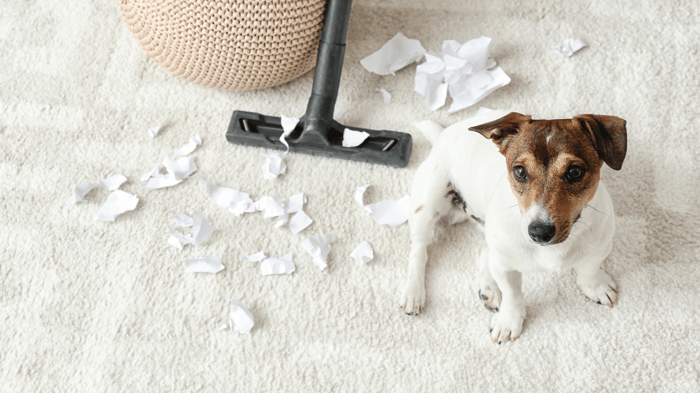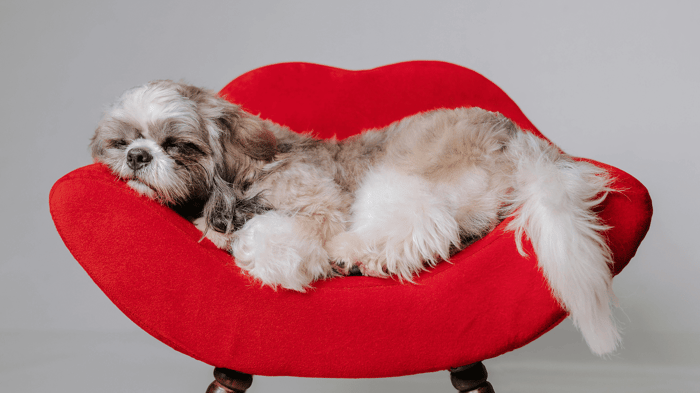You brought home the tiniest pup in the city, and somehow your 600 square feet still feels too small. Cute as a button, loud as a siren, and faster than your reflexes... You’re dodging puddles on the floor, trying to explain barking to your upstairs neighbor, and wondering if this was a mistake. It’s not. You’re just in the thick of it, and fortunately, training can help!
Toy dogs come with oversized personalities.
High energy. High voice. High expectations.
And when there's no yard, no quiet, no break—it starts to wear on you. Maybe you’ve said it in your head: I don’t know if I’m doing this right. Maybe you’ve whispered it out loud. That’s okay.
The truth?
You’re not the only one googling at midnight with a chew toy in your hand and pee pads in your cart. It’s not about being perfect. It’s about being patient. And smart. Because the right training doesn’t need a backyard. It needs strategy.
Small tweaks. Better routines. And a new way to look at life with a tiny dog in a small space.
This blog’s gonna walk you through all of it—potty wins, bark control, energy outlets, calm corners, and routines that actually work. You’ll get answers, not fluff. Practical, tested, and made for dogs like yours.
Let’s make peace with the square footage. Let’s begin.
Tiny Dog, Big Personality: Why Training Starts with Understanding
Your dog isn’t being difficult. They’re being tiny. And that makes a huge difference.
Toy breeds weren’t bred to herd sheep or pull sleds.
They were made to be close—really close—to humans. Carried. Cuddled. Talked to.
That’s centuries of companionship packed into five pounds of fur and feelings. So yeah, they notice everything. The elevator ding. The neighbor’s keys. A squirrel 20 floors below. And because they’re wired to alert you, they sound the alarm. Every. Time.
Now shrink their world. No yard. No fence line. Just walls, doors, and windows. There’s no buffer, so their job as a “watchdog” kicks into overdrive. Barking becomes their default response to boredom, curiosity, or anxiety. Especially in apartments.
But here’s what most people miss: small dogs aren’t easier—they’re just different. They’re sharp. Tuned in. And they get bored fast. If you’re only exercising their body and not their brain, you’ll feel it. Chewed corners, constant barking, restlessness. It’s not rebellion. It’s a cry for engagement.
Try this:
Use food puzzles instead of bowls to slow-feed and stimulate.
Teach one new trick a week. Even five minutes a day builds focus.
Rotate toys like a toy library. Hide a few. Swap them out weekly.
Use tiny training collars made for small dogs—not oversized gear meant for labs. If you're researching the best small shock collar, look for adjustable sensitivity, lightweight design, and gentle vibration options, not jarring jolts.
Your dog doesn’t need tougher training. They need smarter training. Designed for their size, their brain, and their background.
If you’ve been thinking, Why won’t she just calm down?, flip it. Ask, What is she trying to tell me? You’re not dealing with bad behavior. You’re translating a tiny language.

Potty Wins in Small Spaces: Consistency Over Convenience
Potty training a toy dog in an apartment can feel like defusing a tiny bomb several times a day. One wrong move—boom. The rug pays the price.
Here’s the truth most guides skip: toy dogs aren’t being “bad.” Their bladders are just tiny. Think shot-glass small. Add fast metabolism and an excitable nervous system, and they’re clocking out bathroom breaks like a baby on espresso. Expecting them to “hold it” like a lab is unfair—and sets you both up to fail.
Let’s make a plan that actually works in small spaces.
Option 1: Indoor potty setups that don’t destroy your floor—or your vibe
Pee pads in a tray, turf patches on a balcony, or even litter boxes with fake grass. Yes, really. Some toy breeds take to it faster than outdoor-only training.
Choose a dedicated spot. Never move it. Dogs remember by scent and location, not verbal logic.
Spritz with an attractant if needed. Scent cues beat commands every time.
Option 2: Timed outdoor breaks (even if you don’t have a yard)
Use building stairwells, a quiet alley, or that patch of city grass no one ever looks at. Don’t wait for a yard. Own your schedule.
Go out before the accident window. Prevention beats cleanup.
Build Your Potty Clock
Start with this:
First thing in the morning (even before coffee).
15–30 minutes after eating or drinking.
After naps or playtime.
Before bed.
Every 2–3 hours during the day if they’re still learning.
Stick to it like clockwork. Routine creates reliability.
What not to do
Don’t let your pup free-roam until they’ve proven they can hold it.
Don’t punish. It doesn’t teach—it just creates sneaky poopers.
Don’t change commands. “Go potty” means “go potty.” Say it. Mean it. Reward it.
Apartment life doesn’t need to smell like regret. With the right tools, the right timing, and a tiny bit of strategy, your little pup can become reliably house-trained—no yard required.
From Bark Machine to Quiet Companion: Rethinking Vocal Training
In a house, barking echoes. In an apartment, it ricochets.
Toy breeds are notoriously loud for their size—not because they’re rude, but because they’re wired to alert. That rustle outside? A threat. That elevator ding? Suspicious. That neighbor coughing two doors down? Clearly an intruder. And when you’re just 6 pounds soaking wet, your voice becomes your shield.
But it’s not about “bad dogs.” It’s about overstimulated ones.
Before reaching for the best small shock collar on Amazon, ask yourself: What’s triggering this noise? More often than not, it’s a mix of anxiety, boredom, and pure instinct. Toy breeds feel everything more intensely in tight spaces.
Instead of punishing the bark, rewire it.

Start here: quiet isn’t silent—it’s trained
Use a “quiet” cue: When they bark, wait for a brief pause. Say “quiet,” then reward like they just solved a math problem.
Add enrichment: Bored dogs bark more. Rotate toys. Use puzzle feeders. Hide treats.
Block the triggers: Frosted window film keeps them from spotting every passing pigeon. A white noise machine masks hallway echoes.
Tools that actually help (and don’t freak them out)
A tiny training collar for small dogs with vibrate-only settings—not shock—can help redirect attention gently if paired with positive reinforcement.
Doggy earbuds (yes, they exist) or calming compression wraps like ThunderShirts.
Calming sprays or pheromone diffusers designed specifically for small breeds in high-stress spaces.
Your dog isn’t trying to annoy the neighbors. They’re trying to cope. Your job isn’t to silence them—it’s to help them feel safe enough not to shout.
With the right mix of training, tools, and empathy, even the barkiest buddy can learn when to speak and when to chill.
Create a Comfort Corner: Soothing Spaces for Small Dogs
Every dog deserves a space where they can unplug. For toy breeds—who often feel everything all at once—that space isn’t optional. It’s essential.
Think of it like giving your pup their own little bedroom. Not for punishment. Not for crates and confinement. But for calm. A reset button for tiny nervous systems.
In an apartment, space is tight. But a well-placed corner can do more than you think.
Build the calm zone with intention:
Pick a quiet corner away from the main traffic flow. Bonus if it’s tucked or den-like.
Use a soft crate or cozy bed with high sides to create boundaries and safety.
Layer in calming textures—a fleece blanket, a low pillow, a plush toy they love.
Add your scent. An old t-shirt you’ve worn (unwashed) can work better than any store-bought comfort aid.
Keep a safe chew toy or long-lasting treat nearby—think yak chews or a frozen lick mat with peanut butter.
Light matters, too. Dim lamps. Soft background noise. A white noise machine or gentle instrumental music can signal rest time and drown out hallway chaos.
Routine is key. Guide them to this spot after meals, after walks, or during overstimulated moments. Let them learn it’s a place for peace, not isolation.
And if anxiety’s still high? A tiny training collar for small dogs—vibration-only—can gently interrupt spirals of barking or pacing without fear-based correction.
A comfort corner doesn’t just help your dog feel safe. It helps them stay balanced. And in a small space, that makes all the difference.
Small Dog, Big Responsibility: Apartment Etiquette That Matters
In apartment living, walls are thin and patience is thinner. Your dog’s behavior isn’t just about you—it’s about the people who share your floor, your elevator, your mornings.
You’re not just training your dog. You’re building trust with your neighbors.
Here’s how to make peace in close quarters:
Master the Elevator Sit: Before those doors open, ask for a sit. Hold the leash close. No lunging. No nose dives into strangers’ shoes. Treat for calm. Repeat every ride.
Train the Hallway Mindset: Hallways are sensory overload. Desensitize gradually. Walk slowly. Let your dog observe. Use treats to reward silence when they hear footsteps or voices outside your door.
Leash Up with Intention: Toy breeds often feel outmatched. Narrow spaces can trigger fear-based barking or snapping. Use a front-clip harness for control. Redirect with cues before reactivity kicks in.
Cool the Hellos: Not every neighbor wants kisses. Teach your pup to greet politely—or not at all. Calm, leashed, and seated beats bouncing and barking any day.
Etiquette isn’t about rules. It’s about rhythm—how you move together through shared space. And when your dog learns that rhythm, everyone breathes easier.
Tiny Habits, Lasting Results: Why Your Routine Is the Real Secret
Training doesn’t have to be epic. In fact, it shouldn’t be. With toy breeds, the magic lives in the micro-moments—tiny habits done consistently, with kindness.
Five minutes a day beats an hour on Sunday. Why? Because toy dogs learn best through repetition, rhythm, and routine. They don’t need drills. They need rituals.
Here’s how to turn everyday life into a training win:
Meal times = manners practice. Ask for a sit before placing the bowl. It builds patience.
Potty breaks = training reps. Use the same door, same words, same route. Consistency builds confidence.
Walks = focus time. Ask for “look at me” or “heel” during quiet parts of the route. Reward engagement.
Even casual moments—before the leash clicks on, before the elevator opens—are training opportunities. These little rituals layer into something powerful: a dog who knows what to expect and feels safe following your lead.
And when they mess up? Don’t punish. Redirect. Reset. Reward what’s right. Toy dogs don’t need discipline—they need clarity.

If focus is hard to come by, a tiny training collar for small dogs (vibration-only mode) can offer a gentle nudge without fear. It's a cue, not a correction.
The more consistent you are, the less your dog has to guess. And that’s where the relationship really deepens—when your dog isn’t just trained, but tuned in.
Every moment you invest builds the bond you really want. Start small. Repeat often. Let the routine do the work.
Your Tiny Dog Can Thrive Anywhere
You don’t need a backyard. You don’t need silence. You don’t need more square footage. What you do need is a plan—and you’ve got one now.
A toy dog doesn’t take up much space, but they sure fill it. With noise. With love. With needs that don’t shrink just because their paws do. But here’s the truth: small dogs thrive in small spaces when they have structure, stimulation, and a place that feels safe.
It’s not about space.
It’s about connection.
Start by celebrating the little wins—because they add up fast:
One less accident on the rug? That’s a win.
A quiet elevator ride with no barking? Huge.
Ten seconds of calm when the doorbell rings? That’s your hard work showing.
A nap in their calm zone instead of pacing? Proof your efforts matter.
A “sit” before the leash clicks on? That’s trust. That’s training.
Every moment you show up for your dog, they learn to show up for you.
So yes, apartment life with a tiny pup has its hurdles. But it also has its rhythm. You’ve got the tools now—routines, training tips, enrichment ideas. You’re not just managing a small dog. You’re raising a confident one. And with the right mindset, your dog won’t just adapt—they’ll thrive.
Small space. Big heart. Let that be the story.

